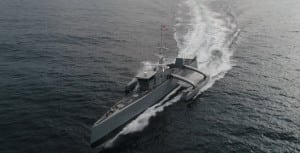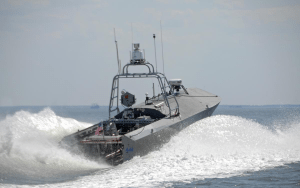The U.S. Pacific Fleet plans to conduct an exercise focused on unmanned systems in early 2021, a Navy official confirmed Tuesday.
“We’re shooting for early 2021 to be able to run a fleet battle problem that is centered on unmanned. And it will again be on the sea, above the sea, and under the sea as we get to demonstrating how we can align to the INDO-PACOM directives to use experimentation to drive lethality,” Rear Adm. Robert Gaucher, Director of Maritime Headquarters at the U.S. Pacific Fleet, said Tuesday during the virtual AUVSI Unmanned Systems conference.

Gaucher explained the Pacific, Atlantic, and European theater groups have been running battle problems where the Navy looks to work on a key operational problem. In, the past they have demonstrated distributed maritime operations largely as carrier strike groups pass through Hawaii or go to Europe.
He said while the service has not yet worked out all the details of the exercise, he confirmed there will be a command and control aspect “as we build and figure out what the best command and control is.”
Gaucher said Pacific Fleet is working with Rear Adm. Lorin Selby, Chief of Naval Research and head of the Office of Naval Research, “and looking to see what his options are for some of the payloads and sensors we can bring in as well as demonstrating some autonomy in an actual fleet problem run by either the shore and at points ships at sea as we go out there.”
In 2018 former commander Adm. Scott Swift reintroduced these exercises that originally occurred from 1923-1940 to test commanders in an aspect of high-end naval warfare. This type of event seeks to see how trained and deployed sailors can deal with planned challenges.
Vice Admiral Ronald Boxall, Director of Force Structure, Resources and Assessment, J8, on the Joint Staff, agreed with the utility of these kinds of tests.
He said the Navy is used to trying to get large programs exactly right before moving forward because the cost of getting them wrong is very expensive.
“We have an opportunity here that smaller platforms, as we explore the unmanned space and the spectrum, to really use these things to iterate. And so prototyping and getting them in the hands of sailors are the ones that are really going to make us much better,” Boxall said.
He added that “we’ve got to find that space where we get comfortable with – what gives us the confidence to proceed to the next level. You know everyone wants to talk about the extreme case, we’re a long way from the extreme case, what we need to do is get things out there and take these baby steps along the way.”
Boxall admitted he will not feel comfortable getting on an autonomously piloted airplane with no pilots for a long time.
“Hence some of the natural resistance that I think we have to expect, we have to be able to communicate it, we have to be able to give confidence that we are proceeding at a good pace but not at the point of stupidity. So this is the opportunity that I see right now that we can bring because a lot of these platforms are smaller and we can demonstrate things in much smaller scale as we bring in both capacity and capability further on down the cycle,” he continued.

Both the House and Senate FY 2021 defense authorization bills included language to limit the Navy’s speed on procuring new unmanned vessels. The House bill would prohibit procuring any large unmanned surface vessels until it has certain technology maturation certifications and guarantee it can be autonomously controlled for at least 30 days (Defense Daily, June 23).
The Senate’s bill similarly requires the Navy to qualify the main engines and generators for unmanned surface vessels before procurement can go forward. This is an effort to require technological maturity and distinguish between subsystems and full-scale prototyping (Defense Daily, June 11).
“We’ve got to find that space where we get comfortable with what gives us the confidence to proceed to the next level. You know everyone wants to talk about the extreme case, we’re a long way for the extreme case. What we need to do is get things out there and take these baby steps along the way,” Boxall said.
He added the question they always get and that Congress has issues with is “how do you know when it’s good enough?”
In contrast, Boxall said they are nowhere near worrying about autonomous kill robot ships.
“That’s not where we’re going, but we’ll never get to some future until we start doing things in the early stage under things we know how to do.”